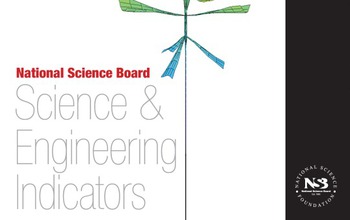![]()
Press Release 14-068
New data show how states are doing in science![]()
Updated tool lets users compare states on education and R&D
|
The state data tool is a supplement to the 2014 Science and Engineering Indicators report. |
May 15, 2014
The newly updated, online, interactive state data tool allows policymakers, educators and other users to discern trends in education, science and research in each of the 50 states. This free resource supplements the state data in the 2014 Science and Engineering Indicators report, the premier source of information and analysis of the nation’s position in science and engineering education and research. The biennial report is published by the National Science Board, the policy making body of the National Science Foundation (NSF).
The tool features 59 state indicators of state performance in education, the scientific workforce, research and development (R&D) investments and activities, and high-tech business. It offers tables, charts and graphs, and permits users to view and customize data in multiple ways, such as making comparisons with other states, looking at 20 year trends, and translating financial information from current into constant dollars.
“R&D and human capital are major drivers of innovation and the economy,” said Dan Arvizu, chairman of the National Science Board. “This is a valuable resource for those who wish to see how their state is doing. Whether it’s educational achievement, your state’s workforce, or R&D investments, it’s an excellent tool to see how your state stacks up. And it will inform debates over state policies and programs.”
Arvizu said the tool is an especially valuable resource for educators and state policymakers in understanding their state’s educational landscape and for corporations and economic development officials interested in a state’s workforce or technology-based business potential.
The state data tool includes indicators on:
State policymakers and other users can consider such factors as how their state compares with neighboring or similar states, as well as with the national average. They can see whether their state is following national trends, such as conducting more R&D over the last decade, or moving in the opposite direction.
For most indicators, the states vary widely. For example:
-
The number of science and engineering bachelor’s degrees awarded in a state ranges from 9 (Alaska) to 39 (Vermont) per 1,000 individuals age 18-24.
-
The share of a state’s workforce employed in science and engineering occupations ranged from 2.2 percent (Mississippi) to 7.6 percent (Virginia).
-
The amount of R&D performed, as a share of a state’s gross domestic product (GDP), ranged from 0.3 percent (Wyoming) to 8 percent (New Mexico).
“These data can shed new light on policy discussions,” Arvizu said. “If you’re lagging behind neighboring states or the rest of the nation, it may inform your assessment of the quality of your educational system or workforce, and what you may need to do to enhance your economic position and competitiveness.”
Researchers can also conduct their own analyses of the data by, for example, studying possible interrelationships among different indicators, such as education, R&D, and economic activity.
The state data tool is produced by NSF’s National Center for Science and Engineering Statistics. It supplements the latest edition of Science and Engineering Indicators, a 600-page volume that is the most comprehensive federal information and analysis of the nation’s position in science and engineering education and research. The Indicators report was released in February 2014.
-NSF-
![]()
Media Contacts
Nadine Lymn, National Science Board, (703) 292-2490, nlymn@nsf.gov
![]()
The National Science Foundation (NSF) is an independent federal agency that supports fundamental research and education across all fields of science and engineering. In fiscal year (FY) 2014, its budget is $7.2 billion. NSF funds reach all 50 states through grants to nearly 2,000 colleges, universities and other institutions. Each year, NSF receives about 50,000 competitive requests for funding, and makes about 11,500 new funding awards. NSF also awards about $593 million in professional and service contracts yearly.
Useful NSF Web Sites:
NSF Home Page: http://www.nsf.gov
NSF News: http://www.nsf.gov/news/
For the News Media: http://www.nsf.gov/news/newsroom.jsp
Science and Engineering Statistics: http://www.nsf.gov/statistics/
Awards Searches: http://www.nsf.gov/awardsearch/
![]()
